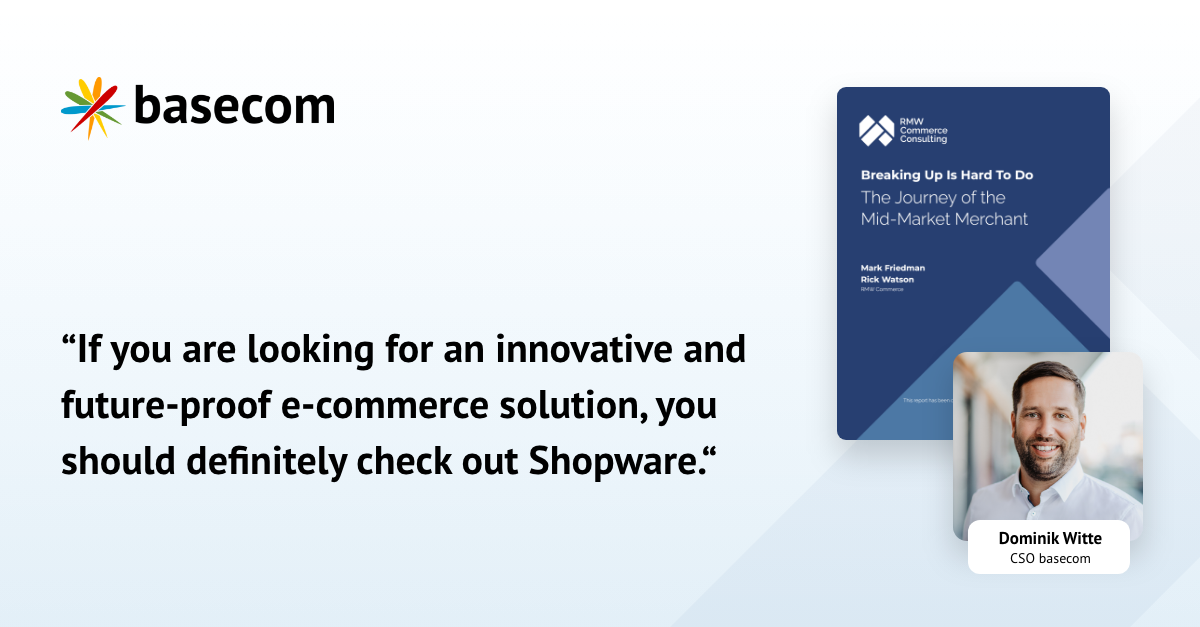New alternatives for the mid-market merchant: Why Shopware is one to keep an eye on

E-commerce in Germany: same, but different
Although the term mid-market has no direct equivalent in the usual classification of company size in German-speaking countries, the extended definition of the term in the Watson Report allows a comparison with parts of the Mittelstand and the large company segment in Germany. Friedman and Watson suggest expanding the definition of the mid-market by turnover (between $10 million and $250 million), as smaller companies also face similar challenges due to the complexity of their business model.
Our experience from numerous system implementation and commerce projects confirms that the requirements of companies from the Mittelstand (usually defined by a turnover between €10 million and €50 million and less than 250 employees) in digital commerce are often the same as those of large companies (turnover over 50 million) in terms of individualization, flexibility, scalability and performance.
One of the main reasons for this is that the German Mittelstand is strongly characterized by manufacturing companies that often sell very special, complex products and large product ranges in the B2B sector.
While the requirements of German Mittelstand companies and large companies with a turnover of up to around €250 million are comparable to those of the American mid-market, the range of suitable e-commerce solutions has developed differently in the DACH region and in the USA. Friedman and Watson point out that there has been little to no movement in mid-market e-commerce in the USA over the last ten years, and retailers have very rarely dared to switch platforms. In Germany and the DACH region, however, the situation is different: new providers such as Shopware and Spryker have developed into viable alternatives to the market leader Magento/Adobe, with the result that many companies here have switched platforms. The main profiteer of Magento’s weakness is Shopware, which was already able to expand its market share among the top 1000 webshops in the DACH region to 12.2% in 2022, replacing Magento (11.8%) in the top position.
Why mid-market merchants should consider Shopware
RMW Commerce points out that mid-market merchants should consider Shopware as an alternative to their legacy systems and the challenger Shopify Plus. We can only confirm this recommendation. Shopware actually provides convincing answers to the questions the mid-market e-commerce is facing, according to RMW Commerce. The open source-based e-commerce platform offers users a high level of flexibility and enables extensive customization, so that even very complex business models can be mapped with Shopware. As an API-first system, Shopware also offers a high level of integration and can be seamlessly connected to third-party systems such as PIM or ERP systems. With its PaaS offering, Shopware provides an excellent solution that combines flexibility, performance and excellent scalability, especially for growing companies.
However, US merchants should consider Shopware for another reason if they want to migrate their commerce platform: Shopware may be a newcomer to the US market, but the system is very well established in Europe and is successfully used as a market-leading commerce solution, especially in the market segments that correspond to the mid-market in the US. IIn other words, it is a mature and proven solution that has already demonstrated its ability to meet the requirements of mid-market merchants and, in the latest version 6.6, comes with a cutting-edge tech stack.
From our perspective, with the experience of numerous commerce projects with Shopware, it is absolutely clear: if you are a mid-market merchant looking for an innovative and future-proof commerce solution – you should definitely get to know Shopware.
Download the full report by Mark Friedman and Rick Watson for RMW Commerce for free here.
Get in touch!
* Required information

Dominik Witte
CSO
d.witte@basecom.de




